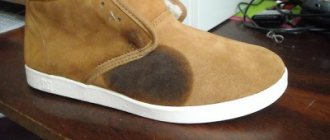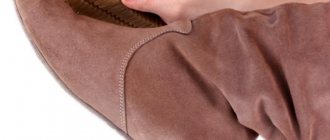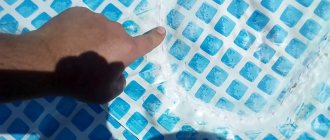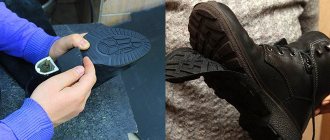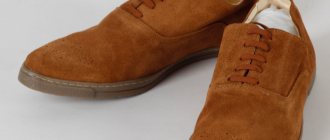In order not to waste time and money on going to a shoe shop, every person should have basic skills so as not to get into an unpleasant situation when you urgently need to leave the house, but the seam on your favorite shoe or sneaker has come apart or the sole has come off. Surely everyone has found themselves in such a situation at least once. The main thing is not to panic, calling your friends and acquaintances with the question, what to do now and how to sew up your shoes? Shoes often tear along the seams, so first you need to free the torn area from old threads.
It is important to choose threads that match the color of those that were originally there. For thin leather, regular sewing threads, preferably silk, are suitable. If the threads are thin, you can fold them in half for strength and rub them with paraffin or soap. The thread treated in this way will glide better when sewing shoes and will not break. Having selected a needle according to the size of the holes left from the old seam, you can carefully sew up the torn area by sticking the needle into the same holes. After repairing the seams, you can think about how to restore suede shoes if the pile is wrinkled and bald spots appear.
You can sew up shoes made of thin leather or suede using a regular sewing needle, but for rough leather this method can be labor-intensive. The needle can break at the most inopportune moment. In order to stitch thick leather you will need a shoe hook and an awl. The threads should also be thicker than regular sewing threads. This can be thin silk or nylon twine. If you cannot match the thread by color, you can use a thin, strong fishing line. Transparent fishing line is suitable for sewing up shoes of any color, including white, before bleaching the shoes.
You can make your own shoe hook from a knitting needle. The knitting needle should be thin and sharp, like the one used for knitting socks. Use a thin file to make a cut at a distance of 3-4 mm from the edge of the knitting needle. A shoe hook is similar to a crochet hook, but has a pointed tip to better pierce leather. Using a hook, you can sew torn seams on shoes and even sew the sole, since it is not always possible to seal shoes with glue. The thread or fishing line for stitching the sole needs to be long, about 30-40 centimeters, it can be longer if the sole is stitched around the entire perimeter.
Don’t forget to clean your white shoes from dirt before you start sewing. Using an awl, a through puncture is made on the outside of the sole, gripping the skin of the shoe. Then, using a crochet hook, you need to pull the thread through the resulting hole so that there are equal pieces of thread inside and outside the shoe. Having made a second puncture with an awl at a distance of 3-5 mm from the first, insert the hook into the hole and grab the thread located inside the shoe. Pull the thread with a loop outward and pull the outer thread into this loop. Holding both ends of the thread, pull them tightly, securing the stitch. This is how the loose sole is stitched stitch by stitch. The seam is strong and even, similar to the seam of a sewing machine.
“And they are still fighting for the honorary title of a house of high culture and life!” - said Anton Semenovich Shpak to the search dog in the immortal comedy “Ivan Vasilyevich Changes His Profession.”
You will not find information on what to do if your suede jacket is stolen in this article. But you can find out! Let's find out!
Suede is a soft, velvety leather made by fat tanning (to give the material elasticity and strength) from the skins of small animals.
Suede is a very thin and delicate velvety leather that absolutely does not tolerate walking through dirt, dust or in rainy times. At the same time, she won’t like the dazzling summer sun either! How to care for such capricious material?
5 stages of suede care.
- After each walk, suede shoes should be cleaned with a special suede brush.
- Dirt that the brush cannot remove can be removed with a special suede eraser. It will also return the velvety feel to the material that was crushed during wear.
- Serious stains can be removed with a foam suede cleaner.
- Moisture-repellent sprays and gels help avoid unnecessary contamination.
- Suede paint can restore the color of shoes.
How to renew suede at home?
If the suede has not received proper care during wear, and you don’t want to spend money on restoring it in dry cleaning, then you can use methods for updating suede at home.
What will you need? The following means:
- laundry soap (or baby soap);
- sodium bicarbonate (baking soda);
- high fat milk;
- semolina;
- ethyl alcohol (or kerosene);
- ammonia;
- wire brush;
- suede care products (paint, brush and water-repellent impregnation);
- soft dry cloth;
- talc (or baby powder);
- sponge;
- magnesium sulfate (magnesia);
- turpentine.
Step 1. Make your shoes clean again
Dust and surface dirt must be removed from the suede using a dry sponge or a special suede brush (you can also use a branded suede eraser or a simple school eraser).
If the shoes are in poor condition, then you need to clean them with soapy water. To do this, rub the sponge with laundry soap, slightly wet it and lather thoroughly. In this case, it is the foam that is the cleaning agent. Apply it to the suede and rub it with a brush. Avoid getting the material excessively wet!
Another way: instead of soap, you can use washing powder or any other detergent.
Important!
Movements when processing suede should be in different directions. This will raise the pile and make further cleaning of the shoes easier.
Step 2: Remove stains
Semolina will help remove stubborn dirt. To do this, you need to cover the stain with semolina, then gently rub it with a wire brush.
If the stain cannot be removed, first hold the area of the stain over steam, and then repeat the procedure again.
Tip: the easiest way to arrange a “steam bath” for suede is over a boiling kettle (near its spout). You should not use a saucepan because the total surface area of the water emitting steam is too large. You may get burned!
Step 3. Fat stains
To remove greasy stains, apply talc to the stained area and leave it on for a quarter of an hour. Shake off any remaining talc. Soak a dry cloth in alcohol or kerosene, and then wipe the dirty area (on top of the applied talcum powder). The procedure should be completed with standard shoe cleaning with a suede brush.
Tip: greasy stains can be easily removed with dishwashing detergent. Apply it to the stain, leave for a quarter of an hour and wash off with a damp cloth.
Step 4. Bald patches
Method 1. You can get rid of bald spots on suede! To do this, you need to mix soda and milk (1 teaspoon and 3 tablespoons, respectively). Use a soft dry cloth to absorb the resulting product and treat the bald spots. After 5 minutes, repeat the procedure, after which the shoes should be left for 30 minutes.
Important!
Do not wet the suede too much; like any leather, it is afraid of excess moisture.
After time, the shoes must be combed with a rubber brush.
Method 2. Ammonia and warm water will help restore the structure of suede at home. The ingredients must be mixed in a ratio of 1:4, after which the surface of the shoe must be treated. This method is also good for.
Step 5. Drying
After completing the procedures, you need to thoroughly dry the shoes. To do this, stuff it with unnecessary paper and leave it to dry naturally.
Avoid drying in direct sunlight and near heating devices!
Tip: Do not use newsprint as padding material, as the ink may leave marks.
Step 6. Restore color
The ideal way to restore the color of suede is to use a special paint. If you don’t have one on your farm, you can use:
- coffee grounds (will help restore the color of dark shoes);
- a mixture of fat milk, magnesia, turpentine and talc in equal quantities.
These products must be applied to the entire surface of the shoe and left for a while. In the case of coffee grounds, this is 12 hours or a day. The milk mixture should be kept for no more than an hour. Then you need to comb the suede with a brush and dry thoroughly.
Step 7: Post Processing
Dried shoes should be brushed again and treated with water-repellent impregnation.
Store suede products in their original packaging. It is highly not recommended to put suede shoes in a plastic bag: this can lead to an unpleasant odor and the formation of mold.
What to do if you don’t have a glue gun - glue for foamiran
The best glue for working with foamiran
– this is silicone glue, as it can be used with a glue gun, which is very convenient.
But if you don’t have this tool on hand, you can use other types of glue to work with plastic suede:
- Cosmofen CA 12 (COSMO CA-500.200) . It grips many different materials, quickly fixes the surfaces to be glued, has high strength, is resistant to external atmospheric influences, high and low temperatures, and does not contain dyes. It is used in the production of toys, processing of rubber, including foamiran, plastics, making jewelry and in many other industries. The cost of a tube weighing 20 g: 99 rubles.
- PVA White Glue from Leeho. It does not deform the surfaces being glued, does not soak the paper, has a thick consistency and white color, and becomes transparent after drying. Does not contain toxins. Used in cardmaking, quilling, scrapbooking and many other types of creativity. Excellent gluing of paper, cardboard, wood and fabric. Suitable for gluing various decorations to foamiran. It has two different dispensers at both ends: for spot application and for applying glue over a large area. The cost of a tube weighing 28 g: 50 rubles.
- Moment Crystal. A clear, quick-fix adhesive solution suitable for both soft and hard materials. Used for gluing rubber, PVC, paper, plastic, foam rubber, cardboard, wood, metal, glass and ceramics. Cost of a 30 ml tube: 58 rubles.
As mentioned just above, it is most convenient to use a glue gun to assemble foamiran parts.
But when using it for foam, you need to know the rules for working with it:
- Before starting work, insert the glue rod into the special hole in the heat gun;
- Plug the tool into a power outlet;
- Heat the gun for 5-7 minutes;
- Carefully pull the trigger - if glue starts to come out of the nozzle, it means it has melted and is ready for use;
- Unplug the heat gun from the outlet for 5 minutes if you do not use it for a while;
- Apply glue evenly and in small quantities to the foamiran, gently pressing the trigger;
- Do not touch the melted glue while working with it, otherwise you may get burned;
- When finished, unplug the gun and let it cool down;
- Wipe off any remaining adhesive with paper or cloth.
How to make a rose from foamiran master class
To create a rose from synthetic suede you will need the following materials:
- Foamiran of any color;
- Strong-hold foamiran flower glue or glue gun;
- Toothpick;
- Regular sponge for washing dishes;
- Wire;
- Beads;
- Scissors.
VIDEO INSTRUCTION
Let's get started:
- On paper, draw three circles that will differ from each other with a diameter of 1 cm;
- Using scissors, cut out the petals from the resulting circles and make them wavy along the edges;
- The smaller the circle, the fewer petals you draw on it;
- Take a sheet of plastic suede;
- Trace the petal shapes on it using a toothpick so as not to stain the material with a pen or pencil;
- Cut petals from foam;
- Bend them into bubbles. They are easy to make from beads glued to hairpins;
- Heat the iron to the starting temperature;
- Attach the petals to the sole of the iron;
- When the material heats up, it will deform on its own - at this moment it must be removed from the sole;
- Place the heated foamian on the sponge and press it inward in the center of the petals;
- It is recommended to stretch the edges of the petals - this way they will become more like a real flower;
- Deform the middle of the petals. To do this, heat it and press it with bubbles - the harder you press, the more closed the bud will be;
- Do the same operations with the other petals;
- To connect them, put a bead on the wire, then twist its edge so that the bead does not fall out;
- Make small holes in the middle of the petals with scissors;
- Pull the wire into the middle of the circle of the smallest petals;
- Apply glue to the area where the wire passes;
- Lower the bead to the gluing area and press it with the petals;
- Bend the petals slightly and apply a little more glue mixture;
- Press them down so that the center of the rose is slightly closed;
- Do the same with the other rows of petals;
- Place all the following petals so that they fit slightly on top of the previous ones;
- The last row can be lightly pressed against the core - then you will get a blooming, lush rose.
By making several of these roses you can create a luxurious topiary. Foamiran is an easy-to-use material from which you can create the most beautiful flowers and other handicraft materials.
“And they are still fighting for the honorary title of a house of high culture and life!” - said Anton Semenovich Shpak to the search dog in the immortal comedy “Ivan Vasilyevich Changes His Profession.”
You will not find information on what to do if your suede jacket is stolen in this article. But you can find out! Let's find out!
Suede is a soft, velvety leather made by fat tanning (to give the material elasticity and strength) from the skins of small animals.
Suede is a very thin and delicate velvety leather that absolutely does not tolerate walking through dirt, dust or in rainy times. At the same time, she won’t like the dazzling summer sun either! How to care for such capricious material?
5 stages of suede care.
- After each walk, suede shoes should be cleaned with a special suede brush.
- Dirt that the brush cannot remove can be removed with a special suede eraser. It will also return the velvety feel to the material that was crushed during wear.
- Serious stains can be removed with a foam suede cleaner.
- Moisture-repellent sprays and gels help avoid unnecessary contamination.
- Suede paint can restore the color of shoes.
On a note
- Each stage of cleaning should be accompanied by complete drying of the shoes.
- Suede is afraid of moisture, and it takes an average of 20 hours to dry completely, so it is not recommended to wear suede shoes every day.
- You can polish suede using a lint-free, dry cloth.
- In order to restore heavily worn suede, you need to use dry cleaning services.
All you need to live gracefully and comfortably is a pair of suede shoes... Three pairs.
Mother of two children. I have been housekeeping for more than 7 years - this is my main job. I like to experiment, I constantly try different means, methods, techniques that can make our life easier, more modern, more fulfilling. I love my family.
Now the fact that our ancestors walked without shoes a long time ago seems at least quite strange. After all, in the twenty-first century, no person in his right mind would leave home without shoes. An exception may be the desire to walk with your feet on grass that is pleasant and tickles your feet. In everyday life it is difficult to live without shoes, rather impossible. Unfortunately, even the best quality shoes deteriorate over time. And you can't do anything about it.
So, how to seal shoes? This is quite simple to do, and there is nothing complicated about it. First of all, you need to find a universal and durable glue that can hold the patch for a long time. And of course a patch. After that, degrease the patch and the place where it will be glued. Then, let the patch dry for about two minutes, and you can begin gluing. The main thing is to correctly calculate the amount of glue and the force that will need to be applied to the patch. You need to press it hard enough, it depends on how long it will last.
How to clean white shoes that get dirty so easily? It all depends on the material. Rubber shoes just need to be wiped with a damp cloth. Everything is simple with sports shoes, which, in most cases, can be thrown into the washing machine. But if the shoes are made of suede, then you cannot do without a special brush or thread. It is strictly forbidden to use cleaning products that are not intended for suede, as unsuitable products can ruin the appearance of the shoes.
Few people think about how to sew up shoes. After all, as a rule, such shoes can be thrown away. Why fix something that is completely broken? Most people do not repair shoes, but simply take these shoes to their country house. After all, at the dacha you don’t have to worry about your appearance. And even more often, such shoes are simply thrown away. But in fact, there is nothing complicated in the process of sewing up shoes. You just need to choose the color and buy special threads, as well as an awl with a hook for stitching shoes.
How to restore suede shoes? After all, suede shoes, which have become so popular lately, are quite easy to damage. You should treat it with the utmost care, because if it comes to damage or scuffs, you will have to fork out money and buy special means for restoring suede. It is simply impossible to restore suede shoes without special products. Apart from them, nothing really will help.
Recently, white shoes have also become widespread. And the question of how to whiten white shoes has become much more common. But it’s easier than ever to do it! All you need to do is take mint toothpaste and a soft cloth. Instead of a cloth, you can use a soft toothbrush. After that, carefully apply a certain amount of toothpaste to the surface of the shoes. All you need to do is rub the paste in thoroughly and diligently.
Products made from suede require careful handling, as it is a very delicate and capricious material. However, even with careful care, a variety of stains and dirt may appear on suede products. It is especially difficult to remove traces of glue from suede at home.
First you need to carefully (with a knife or blade) remove excess glue. This will greatly facilitate further work on cleaning the product.
Petrol
To do this, you need to moisten a dry cloth in gasoline and wipe the contaminated areas with it. But this method will only help when the stain is completely fresh. If the glue has already set, you can try to remove the stain with paint remover or a specialized glue solvent. These products are sold in building materials stores. It should be remembered that suede should not be overly wetted.
Acetone
You need to lightly moisten a napkin in it and gently rub the stains. You can also use any nail polish remover. Acetone is not as effective as gasoline, but it is gentler on suede and helps maintain its good appearance.
Ammonia
To get rid of old stains, use a 5% solution. You need to soak a piece of foam rubber or fabric with this product and wipe off the dirt.
Fresh glue stains can be removed with simple hot water (only the dirt is wetted, not the whole thing) or a cosmetic product for removing false eyelashes. According to some women, this product even removes traces of superglue.
What will help restore the product?
Steam
enhances the impact of all of the above. The suede product is kept over steam for 7–10 minutes, after which it is wiped with one of the products and the glue is carefully removed.
After using any alkaline product, the product must be treated with a special grease for nubuck and suede.
.
This will not only extend the life of the item, but will also help restore the properties of the material. After cleaning, it is advisable to use a special brush or eraser to lift the lint.
You can also hold the item over steam again, this will improve the appearance of the suede.
Finally, be sure to apply a water-repellent spray to the product.
Thus, there are a lot of ways to remove glue from suede items. Well, if you can’t remove glue stains at home, you can always go to dry cleaning.
For home handicrafts, crafts and souvenirs. To fasten natural leather and leatherette, adhesives with completely different compositions are used - based on rubber and polyurethane, polyamide, perchlorovinyl and polyvinyl acetate substances. It is worth understanding their features and rules of use.
Shoe repair rules
Preparation of contact areas is done in the following sequence:
- dry and clean from dirt, sand if necessary;
- degrease with alcohol (solvent, cologne) and wipe dry with a clean, dry cloth;
- apply glue in one or several layers depending on the desired strength of the seam and dry for 5–15 minutes;
- connect the surfaces with considerable force and secure with clamps or weights for a day.
Excess liquid that appears must be removed immediately; later it will be more difficult to do so. The strength of the seam after complete drying depends on the load that will be applied to the bonded surfaces in the first minutes.
The glue emits a strong odor, so the room must be ventilated.
If the adhesive composition is selected in accordance with the recommendations, then the shoes will serve no less than new ones. There is no need to skimp on the quality of the glue - the cost of purchasing it will more than pay off.
A torn boot is a great reason to buy a new pair. But this is not always possible. If the damaged shoes are expensive, very comfortable or well-loved, it would be a shame to throw them away. And here the question arises: how to seal boots securely and neatly?
It is better to take expensive boots to a workshop. Careless handling of glue can aggravate the situation. Professional shoemakers have a lot of experience, and they can make sure that not a trace remains of a hole. But if your hands are not for boredom, and curiosity outweighs the risks, then you can try it!
Genuine vs faux leather
Leather is a high quality natural material, very durable and wear-resistant. Subject to operating conditions and good care, leather will last for many years without losing its original appearance and structure. During the dressing process, different thicknesses and textures are achieved, the skin is dyed and tinted in different colors.
Natural material is used for sewing clothes, shoes, hats and accessories, for upholstering furniture and making decorative items. Leather products are comfortable to wear and durable. The upholstery is practical and comfortable, looks great in the office and at home.
Advice! Natural leather, especially soft and thin, is easily damaged; an artificial alternative is better able to withstand mechanical stress.
Artificial leather has adopted all the external characteristics of its natural counterpart. However, the performance characteristics of leatherette are significantly lower. Fabrics that imitate leather are much cheaper and easier to care for, taking on any shade and texture. The strength and durability of artificial leather and suede is practically not inferior to natural material, but synthetics are less resistant to negative environmental factors: humidity, high and low temperatures, and changes in these indicators. The latest high-quality imitation leather products include eco-leather, a two-layer material that is resistant to abrasion and tearing.
Painting over scratches on patent leather shoes
No matter how high the quality of the varnish layer, it is subject to mechanical wear and cracking. You can remove damage to patent leather shoes: the main thing is to carry out the manipulations as carefully as possible. Before using one method or another, you should thoroughly clean the surface with soapy water and a soft swab. After such a wet “disinfecting” prophylaxis, the stain must be dried. Next we proceed using the following means:
- Nail polish. Colorless or in a tone that matches the skin tone, apply a thin layer and restore the area of paint and varnish;
- A nail polish remover that, once applied, can dissolve nearby areas of remaining nail polish and heal the tear. The product is effective for minor scratches;
- Eraser. Using a light colored eraser, you can smooth out the torn edges, then wipe the area with alcohol. Take a soft cloth moistened with mineral or vegetable oil, wipe the area and polish with a dry cloth;
- Superglue, which is applied in a thin layer to the damage, gluing areas of leather and varnish;
- Polish for patent leather, which is guaranteed to restore the original look.
All means are quite applicable and mask marks on patent leather shoes well, but they only work for a while, so the operation will have to be repeated periodically.
General properties of leather glue
When it becomes necessary to glue the skin, you should choose compounds that are easy to apply and do not flow. It is important that the seam is elastic and durable, not deforming under pressure, compression and stretching. If during operation the finished product will come into contact with the environment, it is necessary that the glue be resistant to moisture, ultraviolet radiation and oxygen, cold and heat, and temperature changes.
What kind of glue should be used for leather:
- elastic and waterproof;
- with good flexibility and toughness;
- resistant to oils and fats;
- cold-resistant and heat-resistant.
Advice! Working with leather glue should be carried out on a clean and dry surface, previously degreased for better adhesion of the adhesive to the base.
When dealing with shoes, bags, outerwear and hats made of genuine leather, craftsmen most often use rubber-based adhesive mixtures. They lie flat and are easy to adjust if necessary.
The textile, furniture and footwear industries require polyurethane or perchlorovinyl adhesives labeled "leather and suede". Such compositions provide a flexible seam that can withstand different operating conditions.
Peculiarities
It is necessary to understand in advance the features of cleaning products made from genuine leather.
How to care
Genuine leather is a material that must be properly cared for. If this is not done, its surface will become covered with dirty spots that will be difficult to clean in the future. It is recommended to wipe leather products with a damp cloth 3-4 times a week.
How not to do it
There are several products that should not be used when caring for leather handbags.
Hard brushes
Some people use hard brushes to remove dried and stubborn stains. Their use is contraindicated, as they can damage the surface. After wiping, marks, abrasions and scratches remain on the skin that cannot be removed.
Wash
Leather handbags cannot be washed in a washing machine, as this may cause the item to become damaged. Instead, you can wipe it with a damp cloth or rag soaked in a solution of ammonia or liquid soap.
Use of solvents
When a lot of dried stains appear on the surface of a leather product, some people decide to get rid of them using solvents. This is a bad idea because such products can corrode the coating and ruin your handbag. Therefore, experts do not recommend using:
Drying
If the product was wiped with a wet cloth, you will have to dry it. Leather handbags must be dried very carefully so as not to damage them. They should not be dried near heating devices or radiators, as this will cause them to become deformed.
How to glue natural and artificial leather
When repairing leather products, a patch is usually used, which is fixed at the site of damage from the outside or inside. For reliable and long-term fastening of the patch, the glue must be thick and viscous, preferably transparent, set quickly and have an elastic structure after drying.
Types of glue suitable for fastening leather and leatherette, fixing additional parts:
- « ».
It has a light shade and thick consistency, is easy to work with, and dries quickly. Nairite compounds are often used in the repair of shoes and various leather goods. - PVA for leather.
It applies well, dries quickly, leaves behind a film that is resistant to temperature and mechanical influences, moisture and sunlight for a long time. - The consistency is viscous and elastic, used for durable gluing of leather and leatherette to each other. Convenient for joining cuts and restoring leather clothing and accessories.
- Universal and fast “Moment”.
It is used for small volumes of work and requires fast and precise movements, as it instantly adheres materials. It is better to remove excess substance immediately, since in a dried form, traces of second glue are difficult to remove. - .
This composition is suitable for connecting materials of different structure and quality to each other, including leather and eco-leather. The peculiarity of using silicone glue on the skin is that for high-quality hardening, the skin must first be stretched and securely fixed until the adhesive seam dries completely.
When working with genuine leather, suede and faux leather, dressmakers often use adhesive tapes for leather or thick fabric. Especially when a leather product needs to be folded or a zipper needs to be replaced.
Liquid skin, how to work with it
A new product used in leather production, sewing clothes and shoes, making hats and leather accessories is a special industrial composition - liquid leather. The substance allows you to replace a section of leather fabric with a new one without patches. This greatly simplifies the repair and restoration process, reduces the cost of the service and speeds up the achievement of results.
Liquid leather allows you to mask scratches, cuts, and cigarette marks as discreetly and quickly as possible. The substance is applied directly to the damage and left until completely dry, and then sanded to give a natural texture.
Advice! If it is necessary to restore a large area, you will need a special fabric backing onto which liquid leather will be applied.
Any glue, including for leather, is accompanied by instructions indicating the order, features and conditions of working with the adhesive composition. First, the master must familiarize himself with useful information about the purchased glue and safety measures, the application method and the time for complete hardening. Only then will the result of gluing work be reliable, high-quality and durable.
Removing scratches from leather shoes
Expensive leather shoes require careful handling, and therefore a caring owner regularly takes care of the surface, applying creams, aerosols and waxes to protect the surface, give shine and a neat appearance. Even a thin layer of decorative cream or protective wax can prevent minor damage caused by abrasive substances that are present even indoors. But these measures cannot prevent the appearance of distinct scratches caused by brute mechanical force.
How can you remove scratches from leather shoes? There are “folk life hacks” with which you can level out minor defects, and there are also quite professional means. The owner chooses which method to use, but first it is worth examining the damaged area and making a conclusion about the depth of the defect: only the paint is damaged or deeper layers are affected.
- A marker that matches the color will temporarily help get rid of noticeable damage. The product is good until the first cleaning. Therefore, you need to put a protective layer of varnish, glue, and wax on top.
- Shoe cream. A good product for eliminating minor defects that only affected a layer of paint. But, like the marker, the cream is very short-lived and therefore requires regular updating.
- Collodion. It is a chemical substance consisting of a solution of cellulose in ether. Like varnish, it dries quickly and forms a protective cover for the area with compromised integrity.
- Wax. Regular beeswax works well to restore the integrity of the skin even with deep damage. Before use, the substance should be heated and a coloring agent selected to match the color of the skin should be added.
- Leather glue. A professional product that can restore damaged areas of material.
- Liquid skin. A type of adhesive composition that is quickly absorbed into the base, creating protection for the treated area. Helps to paint over scratches and restore the uniformity of the surface layer. After application, the liquid product is leveled and dried for half an hour. During this period, if something goes wrong, the liquid skin can be washed off with plain water. Cream or wax must be applied over the dried glue. In case of a deep cut, applying several layers is acceptable.
As you can see, each case has its own means and possibilities. Some of them are less durable, others are more durable, but they all cope with the task very successfully.

